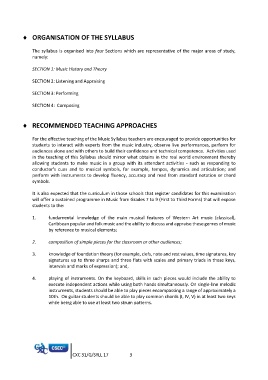Page 1124 - SUBSEC October 2017_Neat
P. 1124
ORGANISATION OF THE SYLLABUS
The syllabus is organised into four Sections which are representative of the major areas of study,
namely:
SECTION 1: Music History and Theory
SECTION 2: Listening and Appraising
SECTION 3: Performing
SECTION 4: Composing
RECOMMENDED TEACHING APPROACHES
For the effective teaching of the Music Syllabus teachers are encouraged to provide opportunities for
students to interact with experts from the music industry, observe live performances, perform for
audiences alone and with others to build their confidence and technical competence. Activities used
in the teaching of this Syllabus should mirror what obtains in the real world environment thereby
allowing students to make music in a group with its attendant activities - such as responding to
conductor's cues and to musical symbols, for example, tempos, dynamics and articulation; and
perform with instruments to develop fluency, accuracy and read from standard notation or chord
symbols.
It is also expected that the curriculum in those schools that register candidates for this examination
will offer a sustained programme in Music from Grades 7 to 9 (First to Third Forms) that will expose
students to the:
1. fundamental knowledge of the main musical features of Western Art music (classical),
Caribbean popular and folk music and the ability to discuss and appraise these genres of music
by reference to musical elements;
2. composition of simple pieces for the classroom or other audiences;
3. knowledge of foundation theory (for example, clefs, note and rest values, time signatures, key
signatures up to three sharps and three flats with scales and primary triads in these keys,
intervals and marks of expression); and,
4. playing of instruments. On the keyboard, skills in such pieces would include the ability to
execute independent actions while using both hands simultaneously. On single-line melodic
instruments, students should be able to play pieces encompassing a range of approximately a
10th. On guitar students should be able to play common chords (I, IV, V) in at least two keys
while being able to use at least two strum patterns.
CXC 31/G/SYLL 17 3

